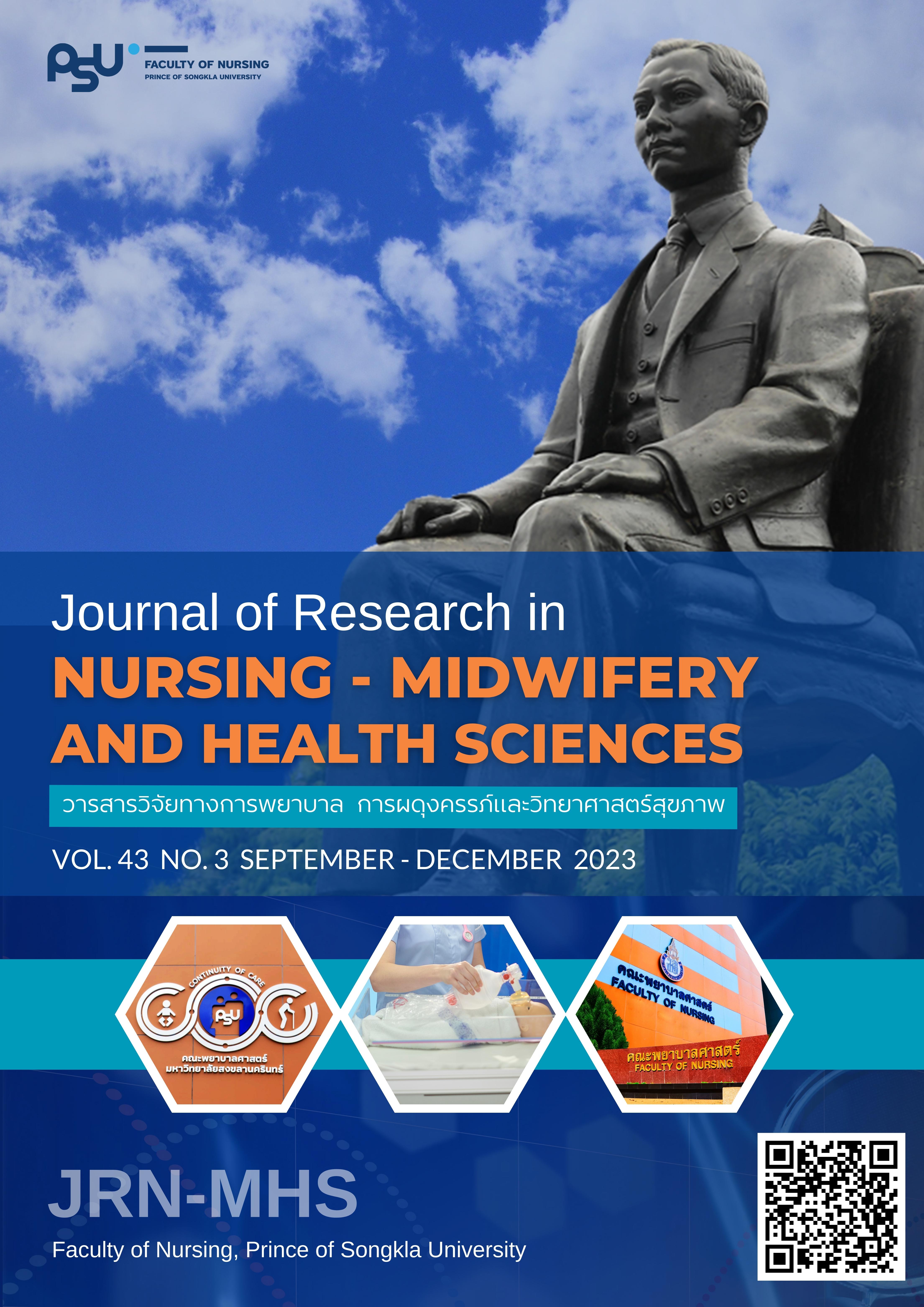ประสิทธิผลของการประคบเย็นด้วยถุงมือโฟมยางธรรมชาติต่ออุณหภูมิชั้นผิวหนังและความพึงพอใจในผู้ใหญ่สุขภาพดี: การทดสอบต้นแบบ
Main Article Content
บทคัดย่อ
วัตถุประสงค์: เพื่อเปรียบเทียบการเปลี่ยนแปลงอุณหภูมิชั้นผิวหนังและความพึงพอใจระหว่างการประคบเย็นด้วยถุงมือโฟมยางธรรมชาติและการประคบเย็นพื้นฐาน วิธีการ: การวิจัยแบบกลุ่มเดียวในผู้ใหญ่สุขภาพดี 27 ราย เก็บรวบรวมข้อมูลด้วยถุงมือโฟมยางธรรมชาติ แผ่นเจลเย็น เครื่องวัดอุณหภูมิดิจิตอลที่มีโพรบ แบบสอบถามข้อมูลส่วนบุคคล แบบบันทึกการเปลี่ยนแปลงอุณหภูมิ และแบบประเมินความพึงพอใจต่อการประคบเย็น มีค่าความตรงเชิงเนื้อหา (S-CVI) เท่ากับ 1 ส่วนความเที่ยงได้ค่าสัมประสิทธิ์แอลฟาของครอนบาค .78 วิเคราะห์ข้อมูลส่วนบุคคลด้วยสถิติเชิงพรรณนา เปรียบเทียบอุณหภูมิชั้นผิวหนังจากการประคบเย็นภายในกลุ่มด้วยสถิติ Friedman test เปรียบเทียบอุณหภูมิชั้นผิวหนังระหว่างการประคบเย็น 2 วิธี ณ นาทีที่ 0, 10, 20, 30, 40, 50 และ 60 ด้วยสถิติ Wilcoxon Signed-Ranks test และเปรียบเทียบความพึงพอใจระหว่างการประคบเย็น 2 วิธี ด้วยสถิติการทดสอบทีคู่ ผลการศึกษา: อุณหภูมิชั้นผิวหนังจากการประคบเย็นแต่ละกลุ่มแตกต่างกันอุณหภูมิชั้นผิวหนังจากการประคบเย็นด้วยถุงมือโฟมยางธรรมชาติ ต่ำกว่าการประคบเย็นพื้นฐาน ณ นาทีที่ 0 แต่สูงกว่าการประคบเย็นพื้นฐาน ณ นาทีที่ 30 ถึง 60 อย่างไรก็ตาม คะแนนเฉลี่ยความพึงพอใจต่อการประคบเย็นด้วยถุงมือโฟมยางธรรมชาติสูงกว่าการประคบเย็นพื้นฐานอย่างมีนัยสำคัญทางสถิติ (t = 7.98, p < .001) สรุป: ถุงมือโฟมยางธรรมชาติช่วยลดอุณหภูมิชั้นผิวหนังได้มากและเร็วกว่าในช่วงเริ่มต้นของการประคบเย็น แต่ลดได้น้อยกว่าในนาทีที่ 30 ถึง 60 และความพึงพอใจในการใช้งานถุงมือโฟมยางธรรมชาติมากกว่าการประคบเย็นพื้นฐาน
Article Details

อนุญาตภายใต้เงื่อนไข Creative Commons Attribution-NonCommercial-NoDerivatives 4.0 International License.
เอกสารอ้างอิง
Liu MM, Tian M, Luo C, et al. Continuous cryotherapy vs. traditional cryotherapy after total knee arthroplasty: A systematic review and meta-analysis of randomized controlled trials. Front Surg. 2023; 11(9): 1-15. doi: 10.3389/fsurg.2022.1073288.
Jette DU, Hunter SJ, Burkett L, et al. Physical therapist management of total knee arthroplasty. Phys Ther. 2020; 100(9): 1603-31. doi: 10.1093/ptj/pzaa099.
Alfuth M, Strietzel M, Vogler T, et al. Cold versus cold compression therapy after shoulder arthroscopy: A prospective randomized clinical trial. Knee Surg Sports Traumatol Arthrosc. 2016; 24(7): 2209-15. doi: http://dx.doi.org/10.1007/s00167-015-3534-7.
Eamchunprathip S, Sae-Sia W, Khupantavee N. Application of cold-press massage to exercise programmes and its effects of patient’s recovery from total knee replacement surgery. JTNMC. 2012; 27(3): 77-90. Thai.
Thienpont E. Does advanced cryotherapy reduce pain and narcotic consumption after knee arthroplasty?. Clin Orthop Relat Res. 2014; 472(11): 3417-23. doi: 10.1007/s11999-014-3810-8.
Ishiguro H, Takashima S, Yoshimura K, et al. Degree of freezing does not affect efficacy of frozen gloves for prevention of docetaxel-induced nail toxicity in breast cancer patients. Support Care Cancer. 2012; 20(9): 2017-24. doi: 10.1007/s00520-011-1308-4.
Kunkle BF, Kothandaraman V, Goodloe JB, et al. Orthopaedic application of cryotherapy: A comprehensive review of the history, basic science, methods, and clinical effectiveness. JBJS. 2021; 9(1): 1-22. doi: 10.2106/JBJS.RVW.20.00016.
Holm B, Husted H, Kehlet H, et al. Effect of knee joint icing on knee extension strength and knee pain early after total knee arthroplasty: A randomized cross-over study. Clin Rehabil. 2012; 26(8): 716-23. doi: 10.1177/0269215511432017.
Lee Y, Shin YS, Kim HJ, et al. Effectiveness and methods of cryotherapy in reducing swelling after total knee arthroplasty: A systematic review on randomized controlled trials. Nurs Open. 2023; 10(9): 5989-98. doi: 10.1002/nop2.1906.
Kanbayashi Y, Sakaguchi K, Ishikawa T, et al. Comparison of the efficacy of cryotherapy and compression therapy for preventing nanoparticle albumin-bound paclitaxel-induced peripheral neuropathy: A prospective self-controlled trial. The Breast. 2020; 49. doi: https://doi.org/10.1016/j.breast.2019.12.011.
Ruddy KJ, Le-Rademacher J, Lacouture ME, et al. Randomized controlled trial of cryotherapy to prevent paclitaxel-induced peripheral neuropathy (RU221511I); an ACCRU trial. Breast. 2019; 48: 89-97. doi: 10.1016/j.breast.2019.09.011.
Şimşek NY, Demir A. Cold application and exercise on development of peripheral neuropathy during Taxane chemotherapy in breast cancer patients: A randomized controlled trial. Asia Pac J Oncol Nurs. 2021; 8(3): 255-66. doi: 10.4103/apjon.apjon-2075.
Bailey AG, Brown JN, Hammond JM. Cryotherapy for the prevention of chemotherapy-induced peripheral neuropathy: A systematic review. J Oncol Pharm Pract. 2021; 27(1): 156-64. doi: 10.1177/1078155220959431.
Shigematsu H, Hirata T, Nishina M, et al. Cryotherapy for the prevention of weekly paclitaxel-induced peripheral adverse events in breast cancer patients. Support Care Cancer. 2020; 28(10): 5005-11. doi: 10.1007/s00520-020-05345-9.
Pingwong K, Sittipa K, Saengploy T. Effectiveness of cold compression for treatment of postpartum perineal injury: A systematic review. JTNMC. 2020; 35(1): 75-85. Thai.
Chughtai M, Sodhi N, Jawad M, et al. Cryotherapy treatment after unicompartmental and total knee arthroplasty: A review. J Arthroplasty. 2017; 32(12): 3822-32. doi: 10.1016/j.arth.2017.07.016.
Changpean S, Chaisiriphuwadol T, Supata W, et al. Development of a cold compress gel from spondias pinnata gum for application as the cold compress gel for nursing pain relief. JHRI. 2023; 6(1): 1-14. Thai.
Kidjawan N. Design thinking process: New perspective in Thai healthcare system. JTNMC. 2018; 33(1): 5-14. Thai.
Roddy L, Polfuss M. Employing design thinking methods in nursing to improve patient outcomes. Nurs Forum. 2020; 55(4): 553-8. doi: 10.1111/nuf.12461.
Altman M, Huang TTK, Breland JY. Design thinking in health care. Prev Chronic Dis. 2018; 27: 15: E117. doi: 10.5888/pcd15.180128.
Bhumisirikul P, Chiannilkulchai N. Development of a RAMA gallbladder retrieval bag for improved patient safety: A Nursing Innovation. Pacific Rim Int J Nurs Res. 2018; 22(3): 264-22.
Lang AR, Martin JL, Sharples S, et al. The effect of design on the usability and real world effectiveness of medical devices: A case study with adolescent users. Appl Ergon. 2013; 44(5): 799-810. doi: 10.1016/j.apergo.2013.02.001.
Surma-Aho A, Hölttä-Otto K, Nelskylä K, et al. Usability issues in the operating room - towards contextual design guidelines for medical device design. Appl Ergon. 2021; 90: 103221. doi: 10.1016/j.apergo.2020.103221.
Coviello M, Abate A, Ippolito F, et al. Continuous cold flow device following total knee arthroplasty: Myths and Reality. Medicina. 2022; 58(11): 1-11. doi: doi.org/10.3390/medicina58111537.
McCarthy MS. Determining skin temperature differences between three cold compression modalities [dissertation]. [Missoula]: University of Montana; 2018. 28 p.
Panphon P. Cold related illnesses [Internet]. Nonthaburi: Center for Continuing Pharmacy Education; 2019 [cited 2023 Aug 25]. Available from: https://ccpe.pharmacycouncil.org/showfile.php?file=386.
Ngamjarus C, Chongsuvivatwong V, McNeil E. n4studies: Sample size calculation for an epidemiological study on a smart device. Siriraj Med J. 2016; 68(3): 160-70.
Breslin M, Lam P, Murrell GA. Acute effects of cold therapy on knee skin surface temperature: Gel pack versus ice bag. BMJ Open Sport Exerc Med. 2015; 1(1): 1-7. doi: 10.1136/bmjsem-2015-000037.
Laha W, Hiruntrakul A, Ninprapan A. The satisfaction of user in the isometric leg strength dynamometer in setting position for field test. KKU Res J (GS). 2018; 18(2): 32-43. Thai.
Lapapontanaanan C. Production technology and rubber form test [internet]. Bangkok: The Office of Industrial Economics, Rubber Intelligence Unit; 2015 [cited 2023 Apr 5]. Available from: http://rubber.oie.go.th/rrd/file/latex_foam.pdf
Aimkosa R, Suksaard C. Comparisons of cryotherapeutic agents efficacy on skin surface temperature changes. JCP. 2018; 13(1): 46-58. Thai.
Garcia C, Karri J, Zacharias NA, et al. Use of cryotherapy for managing chronic pain: An evidence-based narrative. Pain Ther. 2021; 10(1): 81-100. doi: 10.1007/s40122-020-00225-w.
Wang Y, Lu H, Li S, et al. Effect of cold and heat therapies on pain relief in patients with delayed onset muscle soreness: A network meta-analysis. J Rehabil Med. 2022; 54: 1-12. doi: 10.2340/jrm.v53.331.


